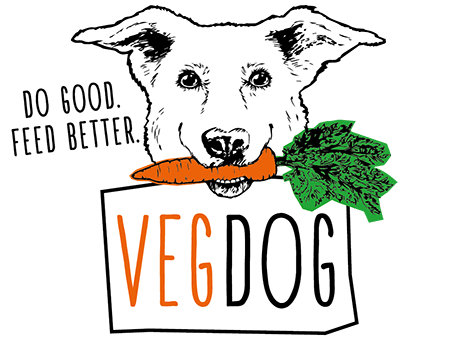
Suitable Food for Dogs – Oils
In the second part of our series “Suitable foods for dogs”, we look at “oil” as an important source of energy and as a supplier of essential fatty acids. You can read the basics about structure, functions and examples of suitable oils for dogs here.
 Author: Carla Steffen
Author: Carla Steffen
 Proofreader: Veronika Hajek
Proofreader: Veronika Hajek
Suitable Food for Dogs - Oils
Part 2: Buying the right oil for your dog!
In the second part of our series “Suitable foods for dogs”, we look at “oil” as an important source of energy and as a supplier of essential fatty acids, especially in vegan dog food . You can read the basics about the structure, functions and examples of suitable oils for dogs here.
Basics about the structure and classification of fats
Fats are compounds of individual fatty acids and glycerine. Depending on whether or not there are double bonds between the carbon atoms, they are referred to as "unsaturated" (e.g. vegetable oil) or "saturated" fatty acids (e.g. butter). The double bonds are relatively sensitive to external influences. They should therefore be protected from light and oxygen in order to reduce oxidation, as this leads to rancidity. The number of carbon atoms varies and leads to the classification into short, medium and long-chain fatty acids. Basically, the more carbon atoms and the more double bonds a fatty acid has, the more sensitive it is. Oil has a wide variety of functions for the body. Firstly, oil is an excellent source of energy. You can significantly increase the energy content of the ration with this food without upsetting the nutrient ratio. If your dog tolerates oil well, you can also add a little oil to the ready-made food. You don't have to worry that the nutrients are no longer in the right proportion. The amount of oil should be individually adjusted to the animal. Caution is advised in the case of certain diseases, for example dogs that already suffer from pancreatitis. These animals should be fed a diet that is as low in fat as possible. In these cases, please ask your vet for advice!
Shiny coat or better learning ability: an individual fatty acid composition for your dog!
Linoleic acid (omega-6 fatty acid) and α-linolenic acid (omega-3 fatty acid) are essential for dogs, which means that they should be supplied through food. Linoleic acid is important for healthy skin and a beautiful coat, which is why deficiency symptoms can be seen in hair loss and dull coat. The healing of wounds can also be impaired. Dogs can use linoleic acid to produce arachidonic acid, a precursor for certain messenger substances (e.g. thromboxanes). Dogs can produce DHA and EPA themselves to a certain extent from α-linolenic acid (e.g. in linseed oil), which play an important role in the development of the nervous system and retina, as well as in inflammatory processes. DHA is also important for the ability to learn. Since it is not known to what extent dogs can synthesize EPA/DHA themselves, we recommend regular supplementation with algae oil. That is why VEGDOG offers VISH OIL , an oil combined from hemp, algae and linseed oil to ensure the most balanced diet possible.
The positive properties of oils are only preserved when stored properly, otherwise the fat becomes rancid and can cause vomiting and diarrhea. It is a good idea to store oils in small, opaque bottles in a cool place. You should screw the lids tightly to reduce oxidation with oxygen.
Examples of oils containing omega-6 and omega-3:
- Omega-3 fatty acids: e.g. linseed, algae, chia oil
- Omega-6 fatty acids: e.g. sunflower, safflower, corn germ, wheat germ oil
- Combined oils (Omega-6 > Omega-3-FS): walnut, soy, hemp oil
- Olive oil is less suitable for your furry friend
If you have any further questions, please feel free to contact our experts at tierarzt@vegdog.de.
The problem with essential oils
Essential oils should be used with caution as they can be toxic to your furry friend. Examples of toxic essential oils include:
- tea tree oil
- eucalyptus oil
- Pennyroyal
- wintergreen
- pine oils
- black cumin oil
In addition, undiluted contact between dog skin and essential oils can lead to skin irritation and, in the worst case, even dizziness or death. They have no health benefits. Essential oils should therefore not be used for dogs.
Frequently Asked Questions (FAQ)
Some human oils contain the same ingredients as the often expensive oils for dogs. However, it should be noted that human oils often contain additives such as fragrances or similar, which can cause skin irritation in your furry friend. Therefore, ask your veterinarian which human oils can also be used for dogs due to the same composition.
Some oils, especially essential oils, are toxic to dogs because they may contain chemicals and other ingredients that our furry friends cannot tolerate. Tea tree oil, for example, contains terpinen-4-ol and cineo. If swallowed or absorbed through the skin, these substances can cause stomach pain, vomiting, dizziness and even breathing problems.
An oil deficiency, or rather a deficiency of certain fatty acids, can be recognized by the deficiency symptoms. These include, for example, increased hair loss or particularly dry skin. A dog diet that meets the needs is therefore crucial for a strong immune system!








